Two books about GTOs to compare before attending the GTO blowout at Pebble this year, viewed by Wallace Wyss and Pete Vack
Ferrari 250GTO: The History of a Legend
Author: Anthony Pritchard
Length: 352 Pages
Publisher: Haynes
Publication date: 2010
Size 11.25 by 9 inches
ISBN-10: 1844255468
ISBN-13: 978-1844255467
By Wallace Wyss
The Ferrari 250 GTO has risen to the top of the Ferrari heap to be one of the most famous Ferraris of all. Whether they made 36 or 39 (depending on which ones you include) the car had an outsized effect on the whole sports car world.
Now that it is almost 50 years since the completion of the first 250 GTO prototype in 1962, there is a new wave of GTO fans that want to read about the car in-depth.
Anthony Pritchard could have been the right man to write the book—he is a diligent researcher and his opinions seem to coincide with other historians. He makes it clear why the 250 GTO dominated the Grand Touring racing category between 1962 and 1964, and to use an American phrase, why it “put on the trailer” such rivals as the Lightweight E-type Jags and Aston Martin DB4GTZ.
Pritchard has written enough books on racing in this period to be able to interpret events and he more or less straightens out for me why Shelby didn’t get the World Manufacturer’s Championship in ’64—that Monza was cut from the schedule (there was still a race there but points won there didn’t go toward the championship) at a point where Ferrari was ahead on points.
But while Cobra historians always claim that Enzo Ferrari maneuvering to have Monza dropped from the schedule cinched it I still can’t understand why, if the Cobras would have done better in the subsequent Tour de France they couldn’t have won? Pritchard, a Brit, seems a bit more pro-Ferrari than pro-Cobra (even though the A.C. Cobras have chassis made in England) when he says things like: “Ferrari had own the GT championship yet again without really trying and Shelby American Cobra had lost it despite pursuing it with great determination. Bearing in mind the amount of misdirected effort that the American team had expended and the heavy costs incurred, both team management and car preparation were mediocre. Carroll Shelby still had to learn that big talk was no substitute for the graft of preparation to the most minute and boring detail.”
Wow! He lets Shelby have it with both barrels! I am surprised he doesn’t call him a failed chicken farmer as well! But overall the book has few such strong opinions, Pritchard being more of a detail man, than an overall commentator on the big picture. And detail is what you buy this book for, both in technical details, race finish details and the pictures.
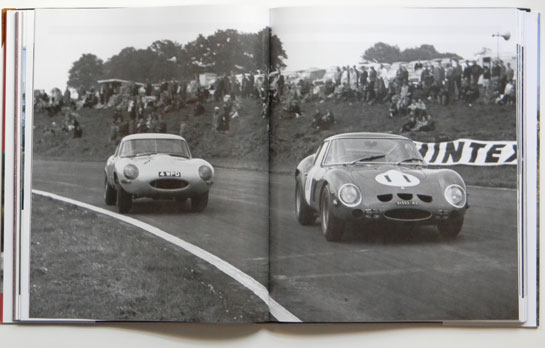
Being a Brit, Pritchard was eager to include many images of the Jags and Aston Martins as well as the GTOs. A good thing, we think.
I bought this book because I have the fantasy of building my own some day (I missed a real one in 1969 for $18,000 but that’s another story). I was hoping they would have a lot of pictures of the various GTOs in their various guises for different races. And there is a lot of that—among the over 250 photographs, most prized of which by far are the period images, showing the cars as they really were, in their original livery.
The book is divided into two parts. The first section chronicles the genesis and development of the car, with a long and profusely illustrated year-by-year account of the car’s racing history via many chapters. The second part is for the extra zealous—going by the serial numbers of each car featuring photographs of the prototypes all of which survive today. He also includes past and present owners.
If you are a real staunch GTO fan, you wish every picture in the book was of a GTO but this book does give you some background into how it came to be and thus needs some other marques pictured and Ferraris leading up to the GTO. Even when it shows Ferraris, it’s a painful to go through his long-winded, “Here is the long wheelbase 250GT” and then “Here is the short wheelbase” etc. when all you want to see is the GTO but I realize that complaint reflects the impatience of the reader than any fault of Pritchard’s.
Some of the most appreciated pictures in the book are of the first body being built at Scaglietti and of the “anteater” prototype where Giotto Bizzarrini would slap bondo on the car at night and do autostrada runs to see which nose shape produced the best top end speeds. Those building models or replicars will appreciate the detail pictures of shift gate, side vents, etc. There’s a magnificent cutaway as well.
There were two things I missed. First, more creative photography like long lens or wide angle shots which would show what the GTO looks like “in modern eyes.”? It is a beautiful car and photographed with modern lenses (not in much use in the Sixties) would make us appreciate it even more. I know Pritchard and I think he is more impressed by a factual rendition in a photograph than something hyped up for glamour but the art side of me likes the glamour shots too. Secondly, he also doesn’t have enough interviews of owners of the cars, either way back when or FROM form who owns them now, but maybe the glamour and owner tidbits belong in a different kind of book—more of a homage– while this is one for the race statisticians, model builders and historian types.
The official price of the book is $85 but on Amazon.com is $59.50. We think this is a great price. You can’t count on books this specialized being around forever, I would say if you are a staunch Ferrari GTO fan, get it now while you still can. I would say one of the great moments in owning this book would be to be at Pebble Beach next week, walking down the line of GTOs, talking to the owners and adding marginal notes on what could be the greatest Ferrari ever built.
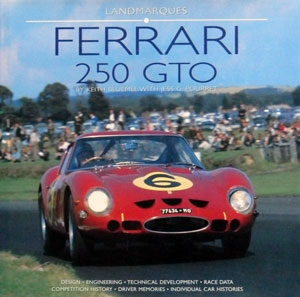
Ferrari 250GTO
Authors: Keith Bluemel and Jess G. Pourret
Length: 192 Pages
Publisher: Bayview Books
Publication date: 1998
Size 10.5 by 10.5 inhces
ISBN-1 901432 15 7
By Pete Vack
With just about everybody revved up to see the GTO display at Pebble Beach, when Wyss sent me the book review above I thought I too, should buy the book to see what Anthony Pritchard brought to the table with his book on the GTO.
So I sat down with the book and it wasn’t too long before I realized that unfortunately the otherwise excellent Pritchard wasn’t up to his very best on this one. In fact, it looked amazingly similar to another book on the subject “Ferrari GTO” by Keith Bluemel and Jess G. Pourret, published in 1998 by Bayview Books. I’m not sure what I expected–perhaps more in depth information about each car via their current owners–or perhaps simply more detail about each car. Maybe I was expecting too much, so I asked Ferrari expert Marcel Massini, who has over 800 books on the marque in his library, what he thought the Pritchard GTO book.
“I was very disappointed when I got it. It’s not just full of errors but also not up-to-date, not at all. It seems to me that he simply copied and pasted from the Pourret-Bluemel book. The best GTO book is probably the Pourret-Bluemel one and it is pretty complete.“
But there is much to be said for the Pritchard book—it is newer larger with more pages and covers the racing scene in much more detail with many more of those all important contemporary photographs. .
Like the Pritchard book, Bluemel and Pourret provide a very lengthy chapter on the evolution of the 250 GT series. But here Pourret‘s research on the subject was downloaded, so to speak, from his earlier work, the Ferrari Legend 250GT Competition first published in 1977 and is well served. Chapters also included the Design and Development, the GTO in Detail, then the main body of the work, the GTOs, car by car. The team followed this up by detailed race reports from around the world and some very impressive memoirs of driving and racing the GTO.
Overall, while the Bluemel/Pourret book is somewhat smaller in size and number of pages, the layout, text and photography are better. It is about equal in terms of black and white vs. color photos, and Pritchard supplied more contemporary racing images, particularly from the U.K. where he is located and paid more attention to the GTO‘s famous competition in terms of the Aston Martins, Cobras and Jags. In addition, Pritchard worked up a userful appendix with tech specs, races and a fairly complete index, while none appear in the Bluemel/Pourret book.
Like Wyss, we found a copy of the Pritchard book at Alibris for only $56, though slightly used. And here is the difference–a good used copy of the Bluemel/Poiurret book can be found on Alibris for $198.50 and another at $325. So while this speaks well of the Bluemel/Pourret effort, it also means that at just one quarter the cost, the Pritchard book suddenly becomes a viable choice.
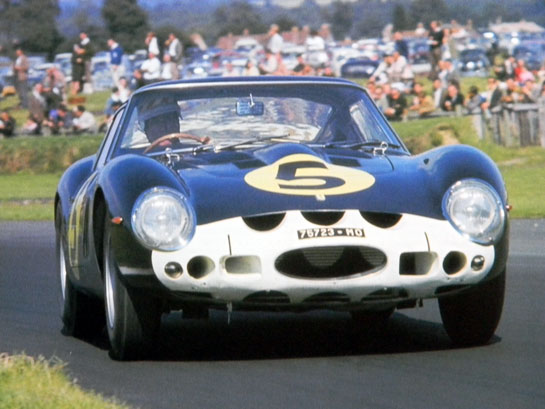
The Bluemel/Pourett book offers a great number of contemporary color images such as this one of Mike Parkes at Goodwood TT in 1962.
So, two good books on the subject, one less costly but not quite as good, the other a classic in itself and priced accordingly. Of the two, you only need one. But if you are really hooked on GTOs, you probably will have to have both or have them already.
Alas, both books lack what I was hoping to find in Pritchard‘s; the essential GTO book, one with all the answers, in-depth interviews with as many owners as possible, a list of current GTO only events in which they have participated, more details and current photos of each car. No, the definitive GTO book has yet to be written. But then I probably wouldn‘t be able to afford it anyway.
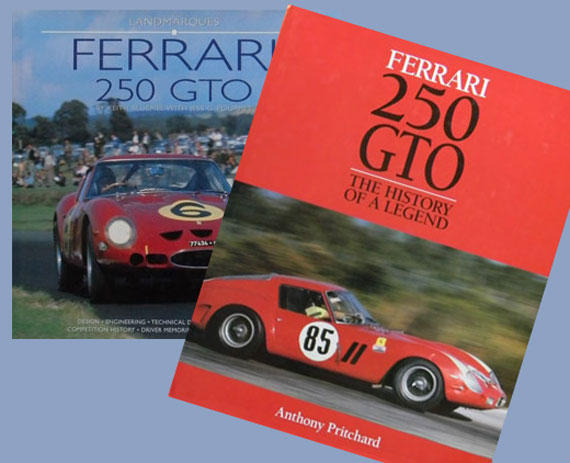
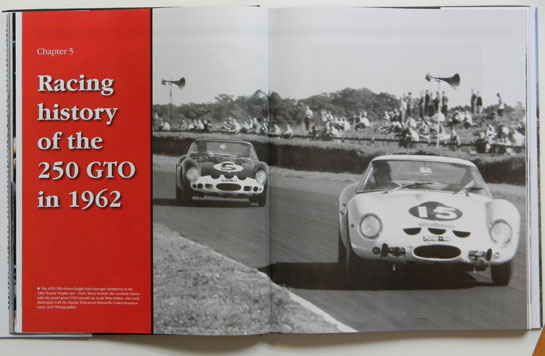
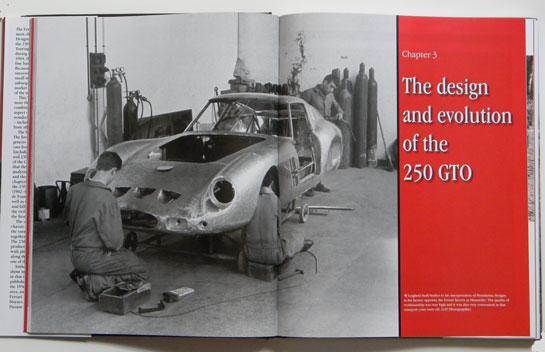
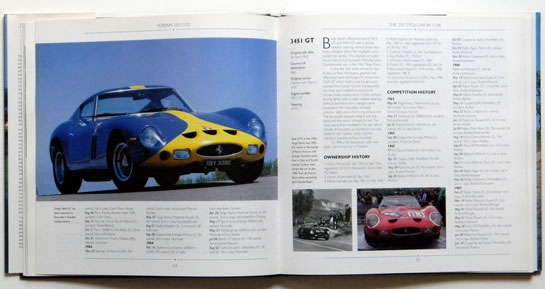
Dear Pete,
I fully agree what you and Marcel said on the Pritchard Book.Only strong point are the many new photos from UK-clubbies..
As for the chassis number and owner stories. Even the Pourret and later Pourret Bluemel chassis stories are ‘unreliable’,dito the race results. IMHO it will be nearly impossible to get the ownerstories straight. In this Million Dollar/Euro business nobody will disclose perfect owner chains to a greater public??
Waiting, as you and others, for the GTO Opus magnum!!
Anyone out there with a decent typewriter??
Best regards Michael